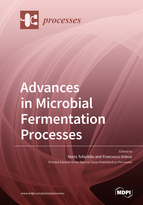Advances in Microbial Fermentation Processes
A special issue of Processes (ISSN 2227-9717). This special issue belongs to the section "Biological Processes and Systems".
Deadline for manuscript submissions: closed (30 April 2021) | Viewed by 52707
Special Issue Editors
Interests: volatile organic compounds; food aroma; food microbiology; food biotechnology; food chemistry; sensory evaluation; flavour chemistry
Special Issues, Collections and Topics in MDPI journals
Interests: beer; wine; agri-food fermentations; microbial starters; microbial biomass production
Special Issues, Collections and Topics in MDPI journals
Special Issue Information
Dear Colleagues,
In the food sector, fermentation processes have been the object of great interest in regards to enhancing the yield, the quality, and the safety of the final product. The microbial fermentation has been traditionally used to produce foods denoted by prolonged shelf life and digestibility. The benefits extended to human health by fermented foods are expressed either directly through the interactions of ingested live microorganisms with the host (probiotic effect) or indirectly as the result of the ingestion of microbial metabolites synthesized during fermentation (biogenic effect). Moreover, several beneficial microbes can inhibit pathogens/spoilers growth and degrade toxins.
Several novel microbial-based biotechnological solutions have been recorded and continuous explorations of microbial diversity are being carried out worldwide. In addition, most recently, fermentation has been considered a sustainable approach for maximizing the utilization of bioresources to address the recent global food crisis. For example, several microbial-base bioconversions have been proposed for the production of enzymes, vitamins, antioxidants, biofuels, feeds, antimicrobial molecules, and other bioactive chemicals, also exploiting agro-industrial wastes.
We encourage the presentation of high-quality contributions (original research articles or review papers) providing innovations in microbial fermentative processes, including improvements of quality/safety of fermented foods and beverages, production of high added-values products, and valorization/recovery of agro-food wastes.
Dr. Maria Tufariello
Guest Editor
Dr. Francesco Grieco
Co-Guest Editor
Manuscript Submission Information
Manuscripts should be submitted online at www.mdpi.com by registering and logging in to this website. Once you are registered, click here to go to the submission form. Manuscripts can be submitted until the deadline. All submissions that pass pre-check are peer-reviewed. Accepted papers will be published continuously in the journal (as soon as accepted) and will be listed together on the special issue website. Research articles, review articles as well as short communications are invited. For planned papers, a title and short abstract (about 100 words) can be sent to the Editorial Office for announcement on this website.
Submitted manuscripts should not have been published previously, nor be under consideration for publication elsewhere (except conference proceedings papers). All manuscripts are thoroughly refereed through a single-blind peer-review process. A guide for authors and other relevant information for submission of manuscripts is available on the Instructions for Authors page. Processes is an international peer-reviewed open access monthly journal published by MDPI.
Please visit the Instructions for Authors page before submitting a manuscript. The Article Processing Charge (APC) for publication in this open access journal is 2400 CHF (Swiss Francs). Submitted papers should be well formatted and use good English. Authors may use MDPI's English editing service prior to publication or during author revisions.
Keywords
- Fermented foods
- fermented beverages
- bioactive compounds
- volatile compounds
- probiotics
- nutrients
- food safety
- food processing
- biotechnologies
- agro-food wastes
- microbial bio-productions
Related Special Issue
- Advances in Microbial Fermentation Processes II in Processes (3 articles)







